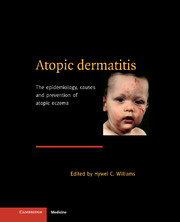Book contents
- Frontmatter
- Contents
- List of contributors
- Foreword Georg Rajka
- Preface
- Part I The nature of the problem
- Part II Descriptive studies which indicate the size of the problem
- Part III Analytical studies which point to causes of atopic dermatitis
- Part IV Intervention studies
- 16 Prevention of atopic dermatitis
- Part V Lessons from other fields of research
- Part VI Conclusions
- Additional information
- Index
- Plate section
16 - Prevention of atopic dermatitis
from Part IV - Intervention studies
Published online by Cambridge University Press: 17 August 2009
- Frontmatter
- Contents
- List of contributors
- Foreword Georg Rajka
- Preface
- Part I The nature of the problem
- Part II Descriptive studies which indicate the size of the problem
- Part III Analytical studies which point to causes of atopic dermatitis
- Part IV Intervention studies
- 16 Prevention of atopic dermatitis
- Part V Lessons from other fields of research
- Part VI Conclusions
- Additional information
- Index
- Plate section
Summary
Introduction
Previous chapters have outlined the evidence suggesting that both genetic and environmental factors are important in the causation of atopic dermatitis (AD). In light of the commonly held belief, particularly amongst layfolk, that AD may be initiated by exposure to certain foods and environmental conditions during childhood, it is not surprising that attempts are often made by parents or medical practitioners to prevent the disease. However, it is clear that AD is a condition of complex aetiology, ensuring that such efforts are unlikely to be straight-forward.
Before considering preventive measures it is necessary to obtain an understanding of disease causation, or at least to devise a conceptual model on which prevention strategies can be based. The first part of this chapter suggests a model for AD causation and then, using this model, outlines some theoretical strategies for prevention. The second part provides a summary of recent studies which have attempted to evaluate the prophylactic benefit of early intervention measures (mostly dietary manipulation), and discusses current recommendations for AD prevention and the implications for future research and public health planning.
Model of atopic dermatitis causation
A conceptual model of AD causation is shown in Figure 16.1. It assumes that the development of AD is a stepwise progression from a state of susceptibility through preclinical to clinical disease. Genetic and environmental factors contribute to the alterations in systemic immune function and local cutaneous physiology that are characteristic of this condition.
- Type
- Chapter
- Information
- Atopic DermatitisThe Epidemiology, Causes and Prevention of Atopic Eczema, pp. 205 - 218Publisher: Cambridge University PressPrint publication year: 2000
- 5
- Cited by



